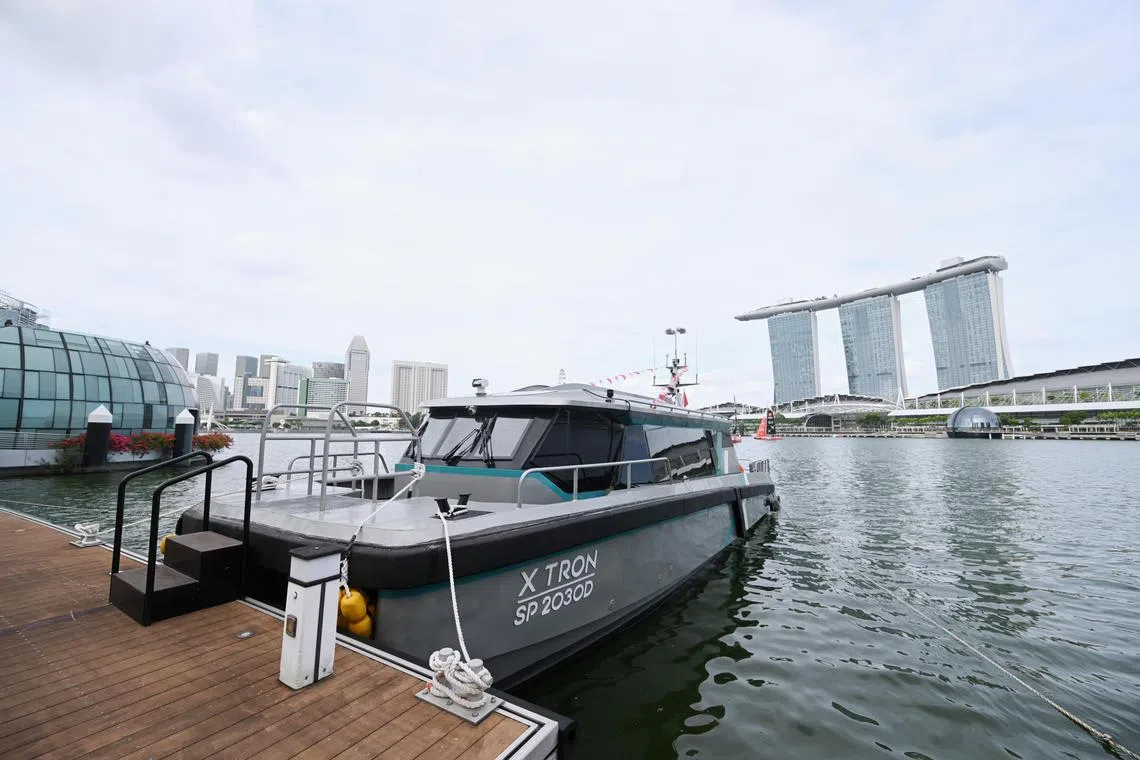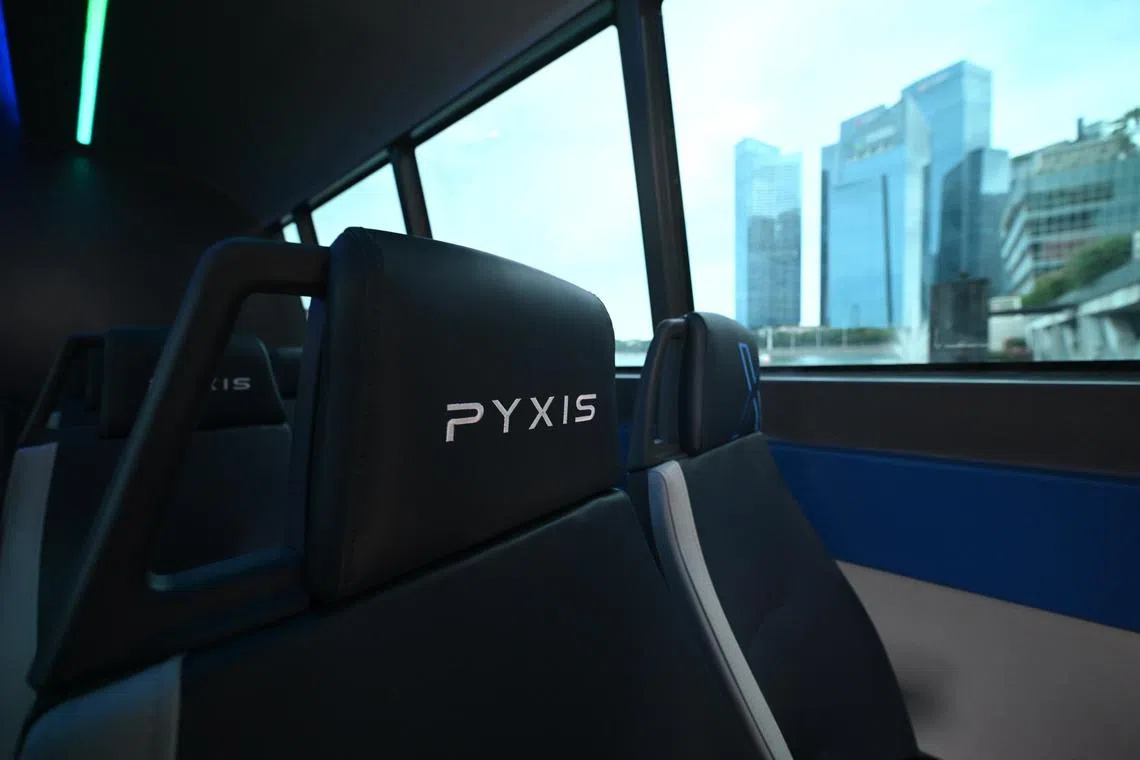S’pore start-up Pyxis debuts fully electric passenger vessel for port and ship workers
Sign up now: Get ST's newsletters delivered to your inbox
Follow topic:
SINGAPORE – The days of having to bear with noxious fumes and the loud chugging of diesel engines on marine craft may be numbered for workers who have to shuttle between mainland Singapore and ships anchored in the Republic’s waters.
With the launch of a new, fully electric workboat named X Tron on March 27, local maritime start-up Pyxis hopes it can give these workers quieter, cleaner and greener rides over the sea.
Measuring 14.8m in length and able to ferry 12 passengers and a crew of two, which is a similar size to conventional diesel equivalents, X Tron is the first in a series of electric port passenger vessels made by Pyxis called Pyxis One.
Featuring the two-hull design of a catamaran, which provides greater stability, the battery-powered vessel has a range of up to 50 nautical miles. For X Tron, which will operate out of Marina South Pier, this range is enough for about two round trips between the pier and its surrounding anchorages.
Using the same charging port as those of electric vehicles, it takes about 2½ hours for the X Tron to get to full charge with a high-speed 150 kW charger. One such charger will be located at Marina South Pier as part of a trial to be conducted by Pyxis and SP Mobility from April.
Pyxis said the X Tron and other vessels in its Pyxis One product line are expected to save up to 120kg of carbon emissions per hour, in comparison with an equivalent diesel vessel. With a more streamlined hull, X Tron is also expected to be 20 per cent to 30 per cent more energy efficient.
The company has two other product lines in the works – Pyxis R, an electric river boat that can accommodate 50 passengers and is designed to be used on the Singapore River for sightseeing tours, and Pyxis L, a more luxurious variant.
All three models share the same hull design, which is made of lightweight, high-strength aluminium sheets. The hull will be manufactured in shipyards outside Singapore and then towed here for final installation and commissioning works for the vessel.
It took about 11 months to manufacture X Tron, and Pyxis hopes to eventually get this down to six months in the future.
Pyxis said it has already secured contracts with local firms York Launch Service, Water B, Singapore River Experience and Eng Motor Launch Service for its three products, and the first Pyxis R will be delivered in the second half of 2024.
York Launch Service and Eng Motor Launch Service offer passenger ferry services within Singapore’s port limits. Singapore River Experience and Water B run river cruise services here.
Including X Tron, Pyxis now has a total of 13 vessels on its order book, and it aims to deliver all of them by 2026. The larger goal is to launch more than 100 electric vessels across the Asia-Pacific region by 2030, it added.

The X Tron features a two-hull catamaran design, which provides greater stability, and has a range of up to 50 nautical miles,
ST PHOTO: AZMI ATHNI
Pyxis founder and chief executive Tommy Phun told reporters on March 27 that it took the company about a year and a half to get X Tron from concept to launch, and the impetus came from shifting government regulations and growing customer demand for green solutions in the maritime sector.
In March 2023, the Maritime and Port Authority of Singapore (MPA) issued a mandate for all new harbour craft in Singapore to be fully electric, capable of using pure biodiesel, or compatible with net-zero fuels such as hydrogen from 2030.
Currently, about 1,600 harbour craft ply Singapore waters. Many of these are smaller vessels servicing larger vessels parked in Singapore waters.
Pyxis, which was founded in 2022, counts 13 existing local maritime firms among its shareholders and list of potential customers, and these firms have helped provide expertise and support to the start-up.
Mr Phun himself has worked in his family’s 30-year-old maritime services company, Eng Hup Shipping, for nine years.
“All of us operate these vessels on a daily basis... We realised if we don’t do anything about (electrification), we will become irrelevant,” Mr Phun said.
Another benefit of going electric is the data that can be mined, he added, noting that Pyxis has developed its own operating system that can tap data from its vessels for things like preventive maintenance and carbon accounting.
The hope is that such innovations can also help to attract younger talent to the maritime sector, Mr Phun said.

The seats of the X Tron, a fully electric port passenger vessel, during its launch at Clifford Pier on March 27.
ST PHOTO: AZMI ATHNI
While the capital expenditure needed for a Pyxis One vessel is twice that of a comparable diesel craft, he said the total cost of ownership over the life cycle of the vessel will “equalise” because operators of electric vessels may not have to spend so much on maintenance and back-ups.
Mr Kieu Kim Sen, managing director of York Launch Service, said his firm has an agreement to charter the X Tron electric vessel for two years. “It is part of a long-term plan of how we are going to pivot, learn about this technology and use it for our future purposes,” he added.
Mr Baey Yam Keng, Senior Parliamentary Secretary for Transport, and Sustainability and the Environment, was the guest of honour at the launch event on March 27. He said Pyxis has been a close partner of MPA in advancing the development of electrification technology and building up local capabilities in this area, adding that collaboration and trust between the industry, workers and the Government are key for the green transition of the maritime sector.


